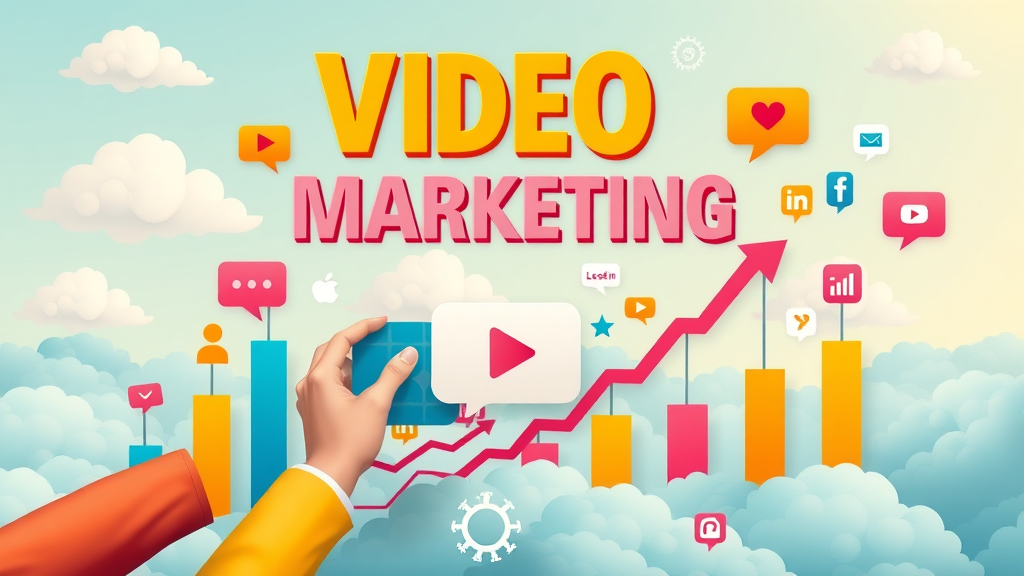
Did you know that over 85% of businesses now credit video as the single most powerful driver of social media engagement? In fact, short form video provides the highest ROI of all video content types and various marketing trends in vogue today. In a digital world overflowing with content, social media video marketing stands tall as a transformative force, connecting brands and audiences like never before. This comprehensive guide cuts through the noise to show how unifying your video marketing with broader social media strategies can catapult your business—fueling more brand awareness, deeper engagement, and outstanding results in 2024 and beyond.
Startling Trends: Why Social Media Video Marketing Dominates in 2024
Video content has rapidly evolved from a “nice-to-have” into the heartbeat of social media marketing strategies. Current trends highlight that businesses, marketers, and creators who leverage social media video marketing are seeing far higher campaign engagement, brand recall, and conversion rates compared to other content forms. Platforms such as Instagram, TikTok, Facebook, and YouTube are rolling out new video-first features, while videos on LinkedIn and Twitter now consistently outperform images or text posts.
What’s fueling this dominance? It’s a combination of audience behavior and platform algorithms. Recent studies reveal that more than 90% of all online content consumed on social media in 2024 is video-based, with short-form video (Reels, Shorts, Stories) leading the charge. These media videos are not only entertaining but statistically proven to deliver a more memorable brand experience and drive higher click-through rates for marketing campaigns. In effect, if your marketing strategy doesn’t place video content front and center, you’re missing out on overwhelming organic reach and ROI potential.
The Surge of Media Video Consumption and Social Media Video Impact
There’s a clear surge in video consumption on every major media platform. Whether it’s a TikTok clip going viral worldwide, YouTube Shorts topping the trending charts, or an Instagram Reel igniting conversation—social media video is captivating audiences in ways images and text simply can’t. Short-form video, live streams, and interactive video ads are now the norm for brands aiming to build authentic connections. As more social networks prioritize video formats, media video becomes the most effective vehicle for increasing customer engagement and expanding reach among target audiences.
Brand awareness campaigns that incorporate tailored video content have experienced up to a 150% increase in social sharing and doubling of average watch time compared to static posts. Videos elicit stronger emotional responses and encourage users to act. Whether you’re a small business or a global brand, integrating media videos into your social media marketing strategy is crucial for cutting through saturation and delivering real results.
“More than 85% of businesses say video is the key driver for social media engagement. – Industry Insider”
What You'll Learn: Achieving Social Media Success Through Video Marketing
Understand the foundations of social media video marketing
Integrate video content with broader marketing strategies
Choose the right video types for each social media platform
Optimize your video production for engagement and conversion
Measure and refine your video marketing strategy

Defining Social Media Video Marketing and Its Core Elements
What is Social Media Video Marketing?
Social media video marketing is the strategic use of video content on social platforms to promote brands, products, or services. It blends elements of both media video production and digital marketing, with a sharp focus on audience engagement and brand awareness. The practice encompasses many forms, including explainer videos, video ads, tutorials, live broadcasts, and user-generated video content. Successful social media video marketing is purpose-driven rather than random—each video aligns with specific business objectives, whether it’s fostering community or driving conversions.
Unlike traditional advertising, media video in the social space invites interaction and storytelling, making it a two-way communication tool. Effective campaigns leverage the unique strengths of each platform – for instance, Instagram Reels for discovery, YouTube videos for education, and TikTok for viral short-form video. By combining quality video production with the right marketing strategy, brands maximize impact and make their content stand out amid the endless social media scroll.
Exploring the Integration of Video Content in Marketing Strategy
Integrating video content into your overall marketing strategy requires thoughtful planning and coordination. Start by outlining key messages, branding guidelines, and audience personas. Consider where social media video fits within your existing campaigns—is it top-of-funnel content for building brand awareness, or more focused on conversions? Use a mix of video types: explainer videos for education, live streams for real-time engagement, and video ads for direct response. Evaluate engagement metrics regularly and adjust video production efforts based on what resonates with your audience.
Brands that succeed with social media video develop a cohesive video marketing strategy that unites creative vision, data-driven goals, and collaborative execution. This approach enables marketing teams to synchronize their efforts across platforms, maintain consistent messaging, and achieve measurable business outcomes.
The Role of Media Video in Modern Social Media Platforms
In 2024, almost every leading social media platform is optimized for video content. Facebook prioritizes native videos in feeds, Instagram’s algorithm pushes Reels to new audiences, while TikTok’s entire ecosystem revolves around viral short-form video. LinkedIn and Twitter are also expanding their video features for B2B and professional brands. The rise of live video and interactive story formats means brands can now connect with their target audience instantly and authentically.
This trend has elevated the importance of creative video production. Short, high-quality video content performs best for awareness and reach, while longer form videos build trust and authority. To stay competitive, marketers must consistently test new formats, video ad styles, and storytelling techniques tailored to each social media platform’s strengths. Ultimately, media videos are central to retaining interest and driving sustained engagement in the modern social media landscape.
Key Features of an Effective Video Marketing Strategy
A truly effective video marketing strategy has several core features: a clear understanding of your target audience, an integrated content calendar aligning video releases with other marketing initiatives, and a balanced blend of video types (explainer video, short-form video, live streams, video ads). Success also hinges on robust video production standards, ensuring every media video is crisp, visually engaging, and on-brand.
Measurement and adaptability complete the formula. Marketers must track not just view counts, but KPIs like engagement rate, average watch time, and conversion metrics. Continual optimization—testing new types of videos, experimenting with different social media platforms, and iterating on creative concepts – is what turns first-time viewers into loyal brand advocates.

People Also Ask: Essential Questions About Social Media Video Marketing
What is social media video marketing?
Answer: Social media video marketing is the practice of using video content on social media channels to achieve marketing objectives such as boosting brand awareness, engagement, or conversions. Videos may take formats like explainer videos, video ads, stories, or live broadcasts, and form the backbone of many successful social media marketing strategies.
What is the 5 5 5 rule for social media?
Answer: The 5 5 5 rule for social media suggests engaging with at least five new profiles, commenting on five posts, and sharing five pieces of content each day to maintain activity and grow your social media community.
What is the 50/30/20 rule for social media?
Answer: The 50/30/20 rule for social media guides content strategy: 50% should engage/entertain, 30% should inform/educate, and 20% should directly promote your brand, products, or services.
What are the 4 types of digital marketing?
Answer: The four main types of digital marketing are content marketing (including video content), search engine optimization (SEO), social media marketing, and pay-per-click (PPC) advertising.

The Foundations of Social Media Video Marketing Strategy
Building a Social Media Marketing Strategy Featuring Video Content
The starting point for any social media video marketing strategy is crystal-clear objectives. Are you looking to boost brand awareness, drive website traffic, or generate leads? Once targets are defined, it’s critical to pinpoint your target audience on each media platform. Gen Z might require punchy TikTok clips, while professional audiences prefer YouTube explainers or LinkedIn presentations. Understanding context helps shape the types of video that fit each stage of the marketing funnel.
Setting objectives for your video marketing strategy
Identifying your target audience on social media platforms
Selecting suitable types of video for your brand
Mapping content across the media platforms your audience uses
Next, develop a content roadmap and style guides for consistency. Decide where explainer videos, product demos, or short form videos fit best. Use analytics and audience feedback to continually refine your approach, ensuring each piece of video content is high quality, on-message, and optimized for the intended platform. Collaboration between your marketing team, creative staff, and product experts is essential—the most successful video campaigns are rarely built in isolation.
Determining the Right Social Media Platforms for Video Marketing
Every platform offers unique video formats and reaches different audiences. For example, Instagram Reels and TikTok suit brief, catchy content that quickly captures attention, while YouTube is ideal for detailed explainers and tutorials. LinkedIn supports B2B thought leadership via interview or behind-the-scenes video, and Facebook caters to diverse demographics with everything from short clips to long-form live broadcasts.
Effective video marketing means matching both content and tone to where your audience spends their time. Analyze platform analytics for insights into video views, shares, and demographic breakdowns. Consider starting with one or two media platforms and expanding as you identify winning video types for each channel. This strategic targeting ensures your video production efforts get the highest possible ROI and long-term brand engagement.
Integrating Video Production into Social Media Campaigns
Integrating quality video production into campaigns is about more than equipment and editing—it’s about crafting a compelling narrative that ties video to broader marketing strategy. Begin by scripting and storyboarding content that aligns with seasonal promotions, product launches, or trending social media topics. Use best practices for video length, ensuring you tailor each piece for the platform, whether that’s a 20-second Instagram Reel or a two-minute Facebook explainer.
Work cross-functionally: have your creative team design eye-catching motion graphics and overlays; your copywriters craft hooks; and your analytics team prepare real-time monitoring for feedback. This level of coordination results in video content that’s creative, data-backed, and successfully integrated into every aspect of your social media marketing.

Case Study: Brand Awareness Through Social Media Video
Consider the case of a retail brand striving to reach Gen Z. They launched a campaign using a blend of TikTok challenges, Instagram Reels behind-the-scenes, and YouTube explainer videos, all leveraging short-form and long-form video content. By tailoring each video for the respective platform’s audience and format, brand awareness soared—the TikTok video reached 500K new users, Instagram engagement doubled, and YouTube subscribers rose by 30%.
The key was consistent branding, cross-promotion, and adapting the content’s tone and style. They also incentivized user-generated video content, encouraging real customers to share product stories. This not only expanded reach but deepened trust with their core audience, proving that a multi-channel, video-first approach dramatically boosts campaign outcomes.
Comparison of Social Media Platforms for Video Marketing: Reach, Engagement, and Best Video Types |
|||
Platform |
Audience Reach |
Engagement Strength |
Best Video Types |
|---|---|---|---|
Huge (ages 18–35) |
High (Reels, Stories) |
Short-form video, Stories, Video Ads |
|
TikTok |
Massive (ages 16–29) |
Very High (viral trends) |
Short-form video, Explainer Video, UGC |
YouTube |
All ages, global |
Strong (longer watch time) |
Long-form video, Explainers, Tutorials |
Wide (ages 25–55+) |
Medium (across formats) |
All formats, Live Video, Ads |
|
Professional (B2B, ages 25+) |
Moderate (thought leadership) |
Explainer Video, Interviews, Company Culture |
Best Practices for Social Media Video Marketing Success
Selecting High-Impact Video Content for Each Campaign
Identifying what type of video content will create the greatest impact starts by understanding your goals and your audience. Use explainer videos for education, short-form video (like YouTube Shorts or Instagram Reels) to capture quick attention, and video ads for direct conversion. Ensure all media video is capable of standing alone while also supporting your overall marketing narrative.
Don’t be afraid to experiment—A/B test different video ad styles and lengths, try user testimonials, and integrate interactive features like polls or shoppable posts. Align every video with the campaign’s objective, from increasing brand awareness to prompting immediate action. High-impact video content is focused, relevant, and optimized for the quirks of each social media platform.
Creating Different Types of Videos: Short-Form, Explainer Videos, and Video Ads
Diversity in the types of video you create is essential. Short-form videos are best for quick brand exposure and going viral, while explainer videos help demystify complex products or processes. Video ads, crafted for specific campaign goals, drive traffic, leads, or sales. For instance, a TikTok challenge can drive organic viral reach, while a targeted Facebook video ad captures intent-driven clicks.
Remember, explainer videos should be clear, concise, and visually compelling. Short-form videos should hook the viewer within the first three seconds, and video ads must deliver a single, strong call-to-action. Mixing these formats in your overall social media video marketing plan maximizes reach, engagement, and your chance of hitting KPIs.
Optimizing Video Production Quality for Maximum Impact
To rise above the noise, superior video production quality is imperative. Invest in sharp visuals, clear audio, professional editing, and consistent branding. Audiences on social media platforms expect slick, fast-paced content—sloppy or amateurish videos can harm your brand. But quality doesn’t always mean high-cost: smartphones and simple lights can yield impressive results if you focus on storytelling and sound fundamentals.
Optimize every media video by testing aspect ratios, subtitles for mobile viewing, and captivating thumbnails. Refresh and repurpose your top-performing assets for new platforms by editing them into different types of videos as needed. In short, make quality, not just quantity, your content mantra.
“The right video format, tailored to each social media platform, can drive 120% higher engagement rates.”

Integrating Video Marketing with Overarching Marketing Strategies
Aligning Social Media Video Content With Overall Marketing Strategy
It’s not enough to create great video; the real magic lies in aligning every social media video with your broader marketing strategy. Set campaign themes, keep messaging consistent across all platforms, and use video to complement other marketing tools like blogs, email, or influencer partnerships. For example, use a Facebook Live video to kick off a product launch, support it with behind-the-scenes Instagram Reels, and follow up with a YouTube explainer video for deeper dives.
Seamless integration ensures that every audience touchpoint reinforces your brand story, multiplies the impact of individual campaigns, and supports measurable goals across the customer journey. Multi-channel storytelling helps cement your message in the minds of your target audience.
Synchronizing Video Campaigns Across Multiple Media Platforms
Synchronizing campaigns means delivering a consistent message but adapting the format for the quirks and strengths of each platform. Use the same campaign slogan or motif in video ads, Instagram Stories, TikTok challenges, and LinkedIn presentations, but change video length, editing style, and calls-to-action to fit each audience. Leverage scheduling and publishing tools to keep cross-platform efforts cohesive without overwhelming your marketing team.
Regularly review analytics to spot trends and opportunities—notice which platform drives the most brand awareness or which video format best boosts conversions. This data-driven, synchronized approach ensures that your video marketing strategy is agile and effective.
Video Marketing Strategy Checklist |
Set measurable objectives for each campaign |
Map target audience segments and preferred platforms |
Choose video types that match goals and audience needs |
Create a unified messaging and branding guideline |
Measure, analyze, and refine with KPIs |
Engaging the Target Audience: Tips for Social Media Video Marketing
Research your audience via social media analytics
A/B test different types of videos (explainer, video ad, short-form)
Use captions and attention-grabbing hooks within the first 3 seconds
Leverage interactive features: polls, shoppable video content
Monitor audience feedback and iteratively optimize
Audience engagement is the secret sauce of social media video marketing. By actively using platform analytics, you can uncover insights into what content draws the most interest and implement rapid improvements. Remember, social media video is inherently interactive—encourage comments, respond to feedback, and experiment with calls-to-action that incentivize deeper participation.

Measuring Success: Metrics for Social Media Video Marketing Campaigns
KPIs for Monitoring Video Marketing Strategy and Brand Awareness
KPIs are your road map for refining video marketing campaigns. Important metrics include view count (reach), average watch time (engagement), click-through rate, shares and comments (virality), and conversion rate. For brand awareness, look at new followers, mentions, and hashtag usage linked to your video campaigns.
Set SMART (Specific, Measurable, Achievable, Relevant, Time-bound) objectives for every social media video marketing effort, and benchmark your results against industry averages. Use real-time dashboards for agile campaign tweaking and report outcomes clearly to stakeholders.
Evaluating the Effectiveness of Your Video Content
Evaluating video content means diving deeper than vanity metrics—analyzing where viewers drop off, how long they engage, and what drives them to take action. Use split testing (A/B testing) to compare versions of video ads or titles.
Track which types of video content most effectively drive audience interaction for your brand. Consider both direct performance (sales, leads) and soft measures (brand sentiment, customer feedback). This cycle of measurement and improvement is crucial for a winning video marketing strategy on any media platform.
Tools for Tracking Video Performance on Social Media Platforms
Most major social media platforms provide built-in analytics tools—Instagram Insights, YouTube Analytics, Facebook Creator Studio, and TikTok Pro accounts all deliver detailed video metrics. Integrate third-party marketing tools as needed to unify reporting across multiple channels.
Important features to monitor include heatmaps (where people watch), audience demographics, and real-time feedback tools. Combining these with robust data from your wider marketing strategy creates a powerful engine for continual growth and optimization.
Adapting Video Marketing for Emerging Social Media Trends

Short-form video is revolutionizing the digital landscape, especially among younger audiences on TikTok, Instagram, and YouTube Shorts. These clips, often under 60 seconds, are engineered for instant impact—low barrier to entry, high potential for virality. Social algorithms are tuned to maximize exposure for creative, timely, and authentic content.
To win with short-form video, brands should keep intros compelling, visuals dynamic, and calls-to-action crystal clear. Experiment with trends and formats (music, challenges, duets), but always align content with broader brand values and campaign goals. Adaptability is the key as new platforms emerge and audience preferences shift rapidly.
Live Video and Interactive Media in Social Media Video Marketing
Live video streams and interactive features (polls, Q&A, shoppable tags) provide brands with real-time access to their audience. Facebook Live, Instagram Live, and YouTube Live are prime platforms for spontaneous, transparent communication—whether it’s a product launch, exclusive interview, or special event.
Engagement rates for live video are among the highest in all of social media marketing. Encourage participation by responding to comments in real time, featuring audience members, and creating events that drive urgency (flash sales, limited offers). Interactive media video helps foster a loyal community and increase brand affinity.
User-Generated Video Content: Unlocking Authentic Media Marketing
User-generated content (UGC) is rapidly becoming a mainstay of successful social media video marketing. By encouraging customers and fans to create videos featuring your products or services, you gain authentic, relatable content and extend your reach organically.
UGC not only amplifies brand awareness but also builds trust. Consider campaigns that incentivize fans to share experiences—contests, hashtag challenges, and featured community stories. Businesses that re-share or respond to UGC show appreciation for their audience and tap into word-of-mouth credibility.
Incorporating Video Ads Into Your Social Media Marketing Strategy
Best Practices for Video Ad Creation and Placement
High-performing video ads are concise, visually arresting, and tailored for each platform’s ideal length and formatting. Start strong—viewers decide within seconds if they’ll continue watching. Use clear branding from the outset, direct messaging, and a powerful call-to-action. Be sure to test multiple ad creatives, using audience insights to refine placement times and targeting for maximum campaign impact.
Placement is equally strategic. Run ads in feed, as Stories, or even in search results depending on your campaign objective. Remember, different audiences engage with different content—so adjust graphics, audio, and captions accordingly.
Retargeting Audiences Using Video Marketing Campaigns
Video is an ideal tool for retargeting. Platforms like Facebook and YouTube allow you to build custom audiences based on video engagement—such as users who watched a certain percentage of your media video. Serve these users a tailored follow-up video ad, special offer, or deeper product explainer.
Retargeting boosts conversion rates and shortens the customer journey, providing a seamless, personalized user experience. Integrate retargeting strategies into your broader video marketing workflow for the strongest results.
Budgeting for Quality Video Production
Budget is a common hurdle for many businesses eyeing video marketing. The good news: with smartphones, user-friendly editing tools, and creative production approaches, high-quality video is more accessible than ever. Allocate budget for key areas: basic equipment (camera, lights, microphone), editing software, and, if needed, professional post-production.
Prioritize spend based on campaign goals—for example, invest more in video ads with direct ROI targets, but use internal teams for short-form content or organic explainer videos. Track spend and campaign performance closely to ensure your marketing efforts are both effective and cost-efficient.
“Successful video marketing starts with clear objectives and ends with actionable insights.”
Video Section: How to Create Engaging Social Media Videos (Demo Video)
Video Section: Analyzing Top Performing Social Media Video Campaigns
Top-performing campaigns often share common threads: strong storytelling, high production value, and a deep understanding of audience triggers. By analyzing best-in-class case studies—across brands, industries, and platforms—you gain actionable insights to refine your own video marketing strategy for lasting success.
Seek inspiration from brands that consistently top engagement charts, and note how they blend entertainment, information, and brand authenticity to create memorable experiences. Adapt the winning formulas while putting your unique spin on each new campaign.
Overcoming Common Challenges in Social Media Video Marketing
Breaking Through Saturation: Originality in Video Content
With social feeds brimming with video, originality is essential. Experiment with fresh formats—stop motion, animation, AR filters, and behind-the-scenes insights. Watch trends but don’t blindly copy—infuse your brand personality and audience insights with every piece of content.
Brainstorm with your marketing team, review high-performing content from competitors, and encourage creative risk-taking. The goal: deliver a memorable user experience that can’t be easily replicated.

Ensuring Accessibility and Inclusivity in Your Social Media Video
Accessibility and inclusivity are now non-negotiables in quality video production. Add captions or subtitles to every media video, use descriptive audio for visually impaired users, and ensure colors and graphics are readable for all.
Beyond technical requirements, reflect diversity in your casting and storytelling. Listen to feedback from your audience and diversity committees, and proactively remove barriers to content participation. Social media video marketing that’s designed for everyone strengthens brand reputation and widens your audience organically.
FAQs: Social Media Video Marketing
How often should I post videos on my social media platforms?
It's best to post at least 1–3 times per week, adjusting based on platform norms and audience response. Test what frequency yields the best engagement for your community.What is the ideal length for social media video content?
Keep short-form videos under 60 seconds. For explainer or educational videos, 2–4 minutes performs best. Always prioritize value and clarity over duration.Which platforms yield the best ROI for video marketing?
Instagram, TikTok, and YouTube offer the highest ROI for most brands, but your results will depend on where your target audience spends their time and interacts with your content.Does video production always require a professional team?
Not always—thanks to modern smartphones and editing apps, solo marketers and small businesses can create compelling, high-quality videos with practice and planning.How can I repurpose video content across different platforms?
Edit originals into shorter or longer cuts, rebrand visually for each channel, and update intros/outros to align with platform style and functionality.
Key Takeaways: Maximizing Results with Social Media Video Marketing
Invest in a clear, audience-driven video marketing strategy
Tailor video content and format for each social media platform
Track performance metrics and adjust campaigns accordingly
Integrate social media video seamlessly into overall marketing strategy
Stay ahead of trends: innovate with emerging social media video features

Conclusion: Transform Your Marketing Strategy with Social Media Video
Final Thoughts on Unifying Social Media Video Marketing
Social media video marketing is more than a trend—it's the cornerstone of modern brand communication. By unifying your video, content, and marketing strategies, you unlock greater reach, engagement, and business growth. Start now and stay agile to lead your market in 2024 and beyond.
Ready to Get Started? Struggling to Gain More Traction with Prospects and Clients? Obtain Your Copy of the “Integrated Video Marketing Strategy for Small Businesses” via this link
Sources
To enhance your understanding of social media video marketing, consider exploring the following resources:
“Social Media Video Marketing: A Guide for 2025” by Sprinklr offers a comprehensive seven-step approach to crafting a successful video marketing strategy, emphasizing alignment with business objectives and audience research. (sprinklr.com)
“7 Steps to Social Media Video Marketing Strategy” by Sprout Social provides actionable insights into repurposing video content across platforms, ensuring maximum reach and engagement. (sproutsocial.com)
These resources will equip you with the knowledge to effectively integrate video content into your social media marketing efforts.
 Add Row
Add Row  Add
Add 




Write A Comment